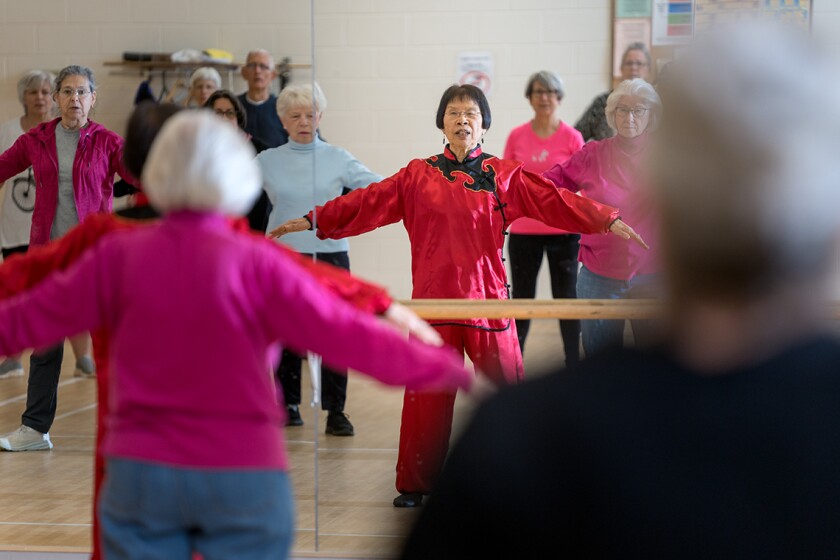Do any of you love to travel? Then join our closed Facebook group, The Ethel On-The-Go, for older women who love a bit of adventure today.
"Stand tall!" my 87-year-old tai chi teacher Young Lee cries out to a dozen of us in her class at a senior center in Maryland. “Reach for the stars!”
"Inhale," she adds firmly. "Exhale. Shake your arms. Gentle. This is not a torture class."
A fit and proud grandmother, Lee embodies the art of aging well. She moves with grace and ease as our instructor of tai chi, an increasingly popular workout found to be a boost for mind, body and spirit, especially in older people. Rooted in martial arts and originating in 17th-century China, tai chi evolved into this slow, controlled-breathing movement, with one posture flowing into the next, providing constant motion.
Now practiced by an estimated 250 million people worldwide, tai chi has become particularly trendy among seniors who want to remain active but prefer to exercise on their feet without getting down on the floor.
Former First Lady Rosalynn Carter was a fan, executing advanced tai chi stances, including one cited by her grandson, Jason Carter, at her funeral service last year.
"She was cool; like she did tai chi with a sword," Jason said, drawing laughter from mourners.
I tried tai chi without a sword, concerned about remaining upright and avoiding falls. As a former longtime tennis player and bicyclist, I was looking for a new activity besides walking my dogs as a fitness routine.

Lee teaches us several different postures to improve our balance. One is where she stands with a foot turned slightly outward, the other ahead of it, pointed straight. "I call this triangle," she says.
With my "triangle," I feel firmly planted, confident I could sustain a collision with a shopping cart in a crowded grocery store or a bump while standing in line for an “Early Bird Special” at a restaurant.
Anyone questioning the cognitive and physical abilities of active and sharp octogenarians, I am witness to my teacher commanding her class flawlessly, going from one posture to the next. This includes the hard "Golden Rooster," which has us standing on one leg and then the other.
"Good," she says.
Now crouching slightly, Lee says, "Fingertips to the knees."
"A little further; fingertips to the calf."
"A little more; fingertips to the ankles."
"A little more; fingertips scoop the floor."
Lee does it effortlessly while many in the class, including me, watch with jaw-dropping awe. Though she's at least 10 years older than most of the students, she seems more flexible and energetic than perhaps any of us.
Lee came to the United States from South Korea in 1967 and worked as a computer programmer. In 1999, she retired with an inoperable ruptured disc, Lyme disease and vertigo. She began walking for exercise, eventually working up to five miles daily. When she began tai chi, she discovered that, coupled with walking, the movements helped restore her strength, stamina and overall health.
In 2004, at 66, she was asked by the head of the senior center in Annapolis if she would like to be a tai chi instructor.
"Tai chi helped me recover. Okay, I will teach," she remembers saying. "I will help other seniors. I like to help seniors stay safe and healthy."
Lee is now in her 25th straight year of practicing tai chi and her 21st year of teaching it. She never participated in organized sports in her homeland. Still, after becoming a tai chi-trained and conditioned athlete, she has participated every year since 1999 in the Senior Olympics, winning dozens of medals in regional, state and international competitions.
In 2019, in the nationals, she won three gold medals in her age group, 80 to 84, in the 1,500- and 5,000-meter power walks and the women's table tennis doubles. Next year, the games will include tai chi for the first time. "I'm hopeful I'll be there," she says.
There is no single national or global governing board of tai chi. Instead, groups, big and small, help manage and grow it. They include The Tai Chi Foundation, an international operation founded in 1976 and now with 31 sites worldwide, including New York City, Dublin, Ireland and London.

"Tai chi is a moving meditation that allows you to feel awareness with your body and a sense of calm and inner peace," Anna Teeples, a foundation instructor in Nashville, told me, "There is a natural beauty to tai chi. The most phenomenal thing, I think, is the attention it is getting from Western doctors on all the health benefits it provides."
An article featured in Harvard Health Publishing echoes those health benefits, stating: “This gentle form of exercise can help maintain strength, flexibility and balance, and could be the perfect activity for the rest of your life."
In an email exchange, Dr. Peter Wayne, director of research at the Osher Center for Integrative Medicine, jointly based at Harvard Medical School and Brigham and Women's Hospital, said: "At its root, tai chi is about treating the whole person and enhancing the balance and crosstalk between the physiological systems that underlie our health, including those linking mind and body."
Wayne, coauthor of "The Harvard Medical School Guide to Tai Chi,” added, "It's a promising intervention for managing and improving many areas of health, especially in older adults, including balance, musculoskeletal pain, cognition, mood and sleep."
After "reaching for the stars,” creating "triangles," and doing the "Golden Rooster," again and again, I sign up for the next 10-week class before this one ends. At 75, I’m confident tai chi, as it did for Lee, can help me on several fronts, including with my vigor, flexibility and mobility ¸— provided I make the time and effort.
I will follow the words she says often, as long as I can, “Again. Again.”
Do any of you practice tai chi? How do you like it? Let us know in the comments below.






